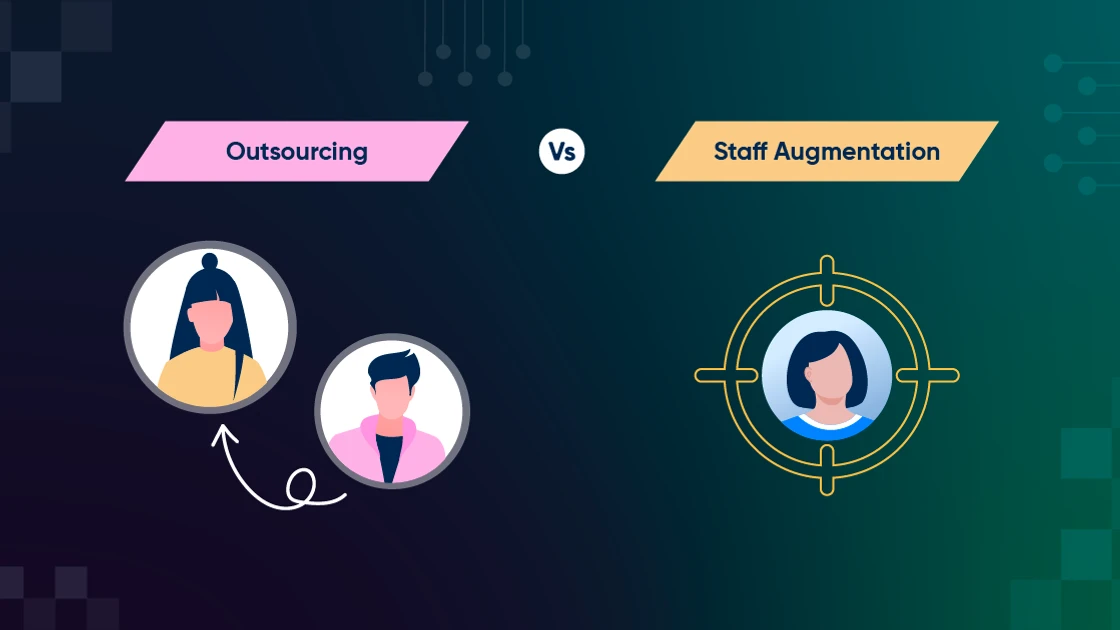When your tech team needs extra hands, figuring out whether to go with staff augmentation or outsourcing is never straightforward. Both models help you bring in skilled professionals, but they work in totally different ways.
The main difference between staff augmentation and outsourcing is the level of control over the project’s execution. IT staff augmentation adds experts to your existing team, while outsourcing hands off entire projects to an external company.
In this blog, we’ll break down the staff augmentation services vs outsourcing debate in clear and practical terms.
Staff Augmentation vs Outsourcing: Key Differences
Aspect | Staff Augmentation | IT Outsourcing |
Definition | Hiring external professionals to work within your internal team | Handing over entire projects or functions to an external organization |
Control Over Execution | Complete control over the tasks and deliverables | Limited control, the vendor leads execution |
Team Integration | Blends into your existing team and workflows | Operates independently, often off-site |
Flexibility | Highly adaptable to changing scope or team needs | Scope and resources are fixed by contract |
Speed of Onboarding | Quick onboarding within days | Slower onboarding due to vendor evaluation and setup |
Ownership of Outcomes | You retain ownership, and internal teams oversee quality and timelines | Vendor owns delivery based on agreed milestones or KPIs |
Cost Structure | Time-based billing with hourly or monthly rates | Fixed or outcome-based pricing based on scope and SLAs |
Suitability | Short-term projects, skill gaps, and rapid scaling | End-to-end product development, long-term IT support |
Talent Scope | Specific roles with targeted skills | Full cross-functional teams provided by the vendor |
Security and IP Control | Easier to enforce policies directly | Requires strict contracts and third-party compliance |
Risk Level | Lower due to direct visibility and quick course corrections | Higher, as it depends on vendor reliability and communication |
Real Example | Hire Java developers for enterprise software development | Outsourcing the entire mobile app development to an offshore team |
What is Staff Augmentation?
IT staff augmentation is all about adding skilled professionals to your in-house team when you need extra support, without hiring full-time. It is a quick way to fill talent gaps during product sprints, migrations, or busy seasons.
These dedicated experts plug into your existing workflow, follow your lead, and help get things done faster. Many companies explore Toptal alternatives to hire tech talent for its flexibility and direct team integration.
Now, when it comes to staff augmentation vs outsourcing, the key difference is control over the execution part. With IT staff augmentation, you guide the work and stay hands-on. If you need flexibility and speed without giving up oversight, staff augmentation might be the smarter fit.
Pros of Staff Augmentation
- Specialized Tech Talent: Staff augmentation gives access to highly skilled developers for niche roles without the long-term investment required for hiring full-time specialists.
- Complete Control Over Task Execution: Staff augmentation allows you to manage tasks directly, maintaining oversight on deliverables, timelines, and quality standards.
- Easy Resources Scaling: You can add or remove developers as project needs change, helping maintain productivity without overcommitting on headcount.
- Cost Effective: You only pay for the hours or days developers work, without onboarding costs and long-term payroll commitments. This makes staff augmentation a lean option for shorter or skill-specific projects.
Quick Onboarding: External specialists can be onboarded quickly, often within days, helping teams meet urgent deadlines or fill expertise gaps.
Cons of Staff Augmentation
- Requires Active Internal Oversight: Since augmented staff integrates with your internal team, you’re responsible for daily coordination, progress tracking, and quality control that can stretch bandwidth for internal teams.
Costly if Hourly Rates are High: While flexible, long-term augmentation at premium rates may outpace the cost of hiring, without careful budgeting and resource planning, extended contracts can eat into margins.
What is IT Outsourcing?
IT outsourcing is a smart way for businesses to hand over specific tech tasks or complete projects to external experts. Instead of managing everything in-house, you collaborate with service providers who specialize in those areas.
This approach allows companies to focus on core goals while leaving the heavy lifting, like building apps, maintaining servers, or running QA, to experienced vendors. The key benefits of outsourcing the project are that it reduces internal load without compromising delivery.
In the staff augmentation vs outsourcing conversation, IT outsourcing stands out as a more hands-off model.
Pros of IT Outsourcing
- Lower Infrastructure and Salary Costs: IT outsourcing reduces the need for physical infrastructure, full-time salaries, and operational overhead. You can shift technical work to external teams and pay only for contracted deliverables.
Internal Teams can Prioritize Strategic Tasks: By handing off execution-heavy work like maintenance or QA, your internal resources can focus on high-impact initiatives. This allows in-house teams to drive innovation, product strategy, and stakeholder alignment.
Cons of IT Outsourcing
- Hidden Costs of Scope Change: Outsourcing contracts are typically based on fixed scopes and timelines. If requirements shift midstream or additional features are added, it can introduce unexpected costs.
- Less Control over Execution: Outsourced teams operate independently based on agreed requirements. While this frees up bandwidth, it also limits your ability to make agile decisions and influence workflows.
- Reliability Depends on Strong SLAs: Project outcomes hinge on clear service-level agreements and consistent monitoring. Without them, quality can suffer due to mismatched expectations, skill gaps, or poor adherence to technical standards.
Poor Communication May Lead to Project Failure: If project briefs, timelines, or goals aren’t clearly defined, outsourced efforts may veer off-course. Delays, rework, or missed deliverables often stem from weak initial scoping or a lack of transparent communication.
Building Smarter Teams with a Hybrid Talent Model
If you’re constantly toggling between tight deadlines, shifting tech priorities, and the need to stay lean, it might be time to rethink your talent approach.
A hybrid model where in-house teams lead strategy, augmented specialists join for high-skill support, and vendors manage outsourced deliverables, offers agility without sacrificing control. It’s the sweet spot for companies that want to move fast but stay hands-on.
For many tech leaders weighing staff augmentation vs IT outsourcing, this middle path solves the puzzle.
C-Suite Checklist: Is the Hybrid Model Right for You?
Use this quick test to assess this decision:
- You need high-touch ownership of core functions, but want to offload operational layers
- You want flexible access to niche tech talent
- Your delivery goals demand speed, but your budget demands intelligent allocation
- You’re juggling internal priorities that compete with maintenance and scalability needs
You want to balance innovation velocity with a predictable vendor outcome
When leaders understand the difference between staff augmentation and outsourcing, they gain the power to mix talent streams in ways that accelerate growth without overextending internal bandwidth.
Wrapping Up
There’s no universal answer to the staff augmentation vs outsourcing question, and that’s a good thing. The most effective choice depends entirely on where your company stands today and where it's headed next.
That said, if retaining control, accelerating time-to-market, and integrating talent seamlessly into your existing workflows are key goals, IT staff augmentation often delivers greater flexibility without the trade-offs.
Understanding staff augmentation vs IT outsourcing helps leaders build smarter, leaner delivery engines. If you're ready to streamline your operations, schedule a meeting to hire dedicated developers who can get up to speed quickly and deliver real value.
Frequently Asked Questions
Q. How do you measure ROI for each approach?
Staff augmentation benefits enable you to onboard new talent quickly and establish a balance between hourly rates and output delivered, as well as the savings from skipping full recruitment cycles. In contrast, outsourcing ROI tends to focus on overall project cost, how well timelines are met, and the advantage of freeing up internal teams.
Q. How do you handle performance issues in each model?
In IT staff augmentation, you have direct oversight and can swiftly intervene or request a replacement as needed. But with outsourcing, performance issues go through vendor escalation protocols, which often require formal feedback, contractual reviews, and sometimes penalty clauses depending on your SLA terms.
Q. How do you manage code quality and development standards?
Maintaining technical consistency depends heavily on the structure of your team. The staff augmentation model provides you with tight control, allowing you to enforce coding standards in real-time through internal reviews, collaborative development, and daily syncs. For outsourced projects, the focus shifts to upfront documentation and checkpoints.


